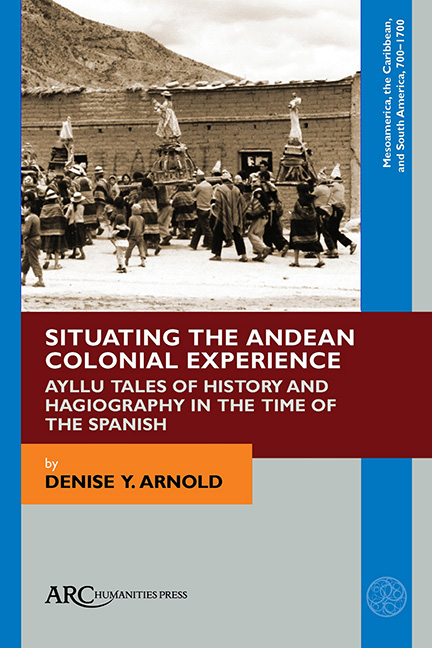 Situating the Andean Colonial Experience
Situating the Andean Colonial Experience Book contents
- Frontmatter
- Contents
- List of Illustrations
- Note About the Spelling of Toponyms and Proper Names
- Acknowledgements
- Maps
- Introduction
- PART ONE THE ORAL HISTORY OF QAQACHAKA
- PART TWO THE COLONIAL CACIQUES IN ORAL AND WRITTEN HISTORY
- PART THREE QAQACHAKA MARKA
- PART FOUR THE SAINTS APPEAR
- PART FIVE THE RELIGIOUS PRACTICES OF QAQACHAKA MARKA
- Some Conclusions
- Glossary
- Appendix A Document C of Don Franco Quispe Maraza
- Appendix B Document K of Don Franco Quispe Maraza
- Bibliography
- Thematic Index
- Index of Toponyms
Chapter 2 - The First Ancestors of the Place
Published online by Cambridge University Press: 22 June 2021
- Frontmatter
- Contents
- List of Illustrations
- Note About the Spelling of Toponyms and Proper Names
- Acknowledgements
- Maps
- Introduction
- PART ONE THE ORAL HISTORY OF QAQACHAKA
- PART TWO THE COLONIAL CACIQUES IN ORAL AND WRITTEN HISTORY
- PART THREE QAQACHAKA MARKA
- PART FOUR THE SAINTS APPEAR
- PART FIVE THE RELIGIOUS PRACTICES OF QAQACHAKA MARKA
- Some Conclusions
- Glossary
- Appendix A Document C of Don Franco Quispe Maraza
- Appendix B Document K of Don Franco Quispe Maraza
- Bibliography
- Thematic Index
- Index of Toponyms
Summary
It's a rocky place, that's why it's called Qaqa …
Don Franco Quispe, from the hamlet of QañawiTHE MEMORIES OF Qaqachaka's inhabitants about the first ancestors of the place and their characteristics are just as fragmentary as their narratives about the origins of the place. In general, their commentaries about them begin with observations about the local people, and the particularities that distinguish them from neighbouring pueblos. These commentaries stress how, to identify the provenance of someone, you observe their face, the intonation of their voice while speaking, and their kind of dress.
Differences between the comunarios of the locality are also noted: that some people have round faces (muruq iñnaqani), which they associate with those who used to speak Uru, while others have long faces (sayt’u iñnaqani), which they associate with speakers of Aymara and Quechua. Then Quechua speakers are distinguished from Aymara speakers by the shh sound in their speech.
It is common in these commentaries to remark on the origins of some inhabitants in Uru-speaking pueblos, especially among older people who can still remember their recent interactions with the inhabitants of Lake Poopó, where they went in search of dried fish in exchange for freeze-dried potatoes (chuñu) and other highland products. Don Tiburcio Maraza, from the Maraza family of Livichuco, offered us a linguistic interpretation about this kind of first ancestor:
My grandparents said we used to speak Uru. This pueblo of Qaqachaka used to speak Uru; here in our very pueblo it used to be Uru. They talked Uru. We would have spoken Uru. Then we just forgot it. They say that until now the Chipayas braid their hair. And they speak Chipaya, they say. We didn't speak it well, they say. We spoke more Aymara and Quechua. And Uru. Now we speak just Aymara and Quechua.
These commentaries accord with the information registered in the census of 1570 by Pedro de Zárate, where it specifies that the province of Paria had 70 percent of Uru speakers and only 30 percent of Aymara speakers. And although Condocondo and its immediate surroundings had a majority of Aymara speakers, the shores to the east and south of Lake Poopó were settled by speakers of Uru-Chipaya.
- Type
- Chapter
- Information
- Situating the Andean Colonial ExperienceAyllu Tales of History and Hagiography in the Time of the Spanish, pp. 45 - 58Publisher: Amsterdam University PressPrint publication year: 2021
